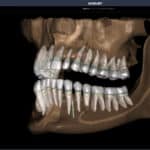From gamified apps to remote monitoring, digital tools help teens stay compliant and give adults the convenience and clarity they expect.
By Jessie Gainor
Engaging patients in their orthodontic journey has always been a challenge. Adolescents need motivation to stay on track, while adults often demand convenience and clarity. Today, digital tools—from apps to virtual monitoring—are giving orthodontists new ways to connect with both groups and keep them engaged throughout treatment. The goal is the same: better compliance, smoother workflows, and ultimately, improved outcomes.
The Technology Landscape
Orthodontic practices are already adopting digital workflows for diagnostics, planning, and appliance fabrication. But technology’s role in patient engagement is equally critical. Platforms that blend communication, education, and accountability can help orthodontists meet patients where they are—on their phones, in their homes, and in the flow of their daily lives.
From customized apps that gamify compliance to remote monitoring systems that let patients avoid unnecessary office visits, the options are growing quickly. But success often depends on tailoring the technology to the patient population. What works for a 14-year-old may not resonate with a 40-year-old balancing treatment with work and family obligations.
Technology for the Adolescent Patient
For adolescent patients, the biggest hurdle is compliance—wearing aligners as prescribed, maintaining hygiene, and showing up for scheduled visits. Technology can help shift responsibility from the parent–child dynamic to a more patient-driven approach.
- Gamification and Motivation. Many aligner companies and third-party developers now offer gamified apps that reward patients for wearing aligners or brushing. Teens can log wear time, track progress, and earn badges or points. While it may seem trivial, these small incentives can make compliance less of a chore and more of a challenge to beat. Gamification can work particularly well for younger adolescents who thrive on visual feedback and competition.
- Remote Monitoring for Accountability. Remote monitoring platforms allow orthodontists to track treatment progress using smartphone photos or scans. For teens, this adds accountability: they know their orthodontist will see whether elastics are being worn correctly or if aligners are fitting as intended. Parents often appreciate the reduced number of in-person visits, while practices benefit from fewer emergency appointments.
- Communication Tools Parents Can Use. While the goal is to empower adolescents, parents remain key partners. Some apps allow parents to receive notifications about wear-time compliance, upcoming appointments, or hygiene reminders. These tools reduce conflict in the home because the reminders come from the system—not from the parent.
- Educational Content in Bite-Sized Pieces. Adolescents respond better to short, engaging content than to long explanations. Practices are creating TikTok-style videos or leveraging vendor-provided clips to explain topics like “why elastics matter” or “how to clean your aligners.” Delivering these through apps, email, or even QR codes in the office keeps the information accessible and engaging.
Technology for the Adult Patient
Adult orthodontic patients are often motivated, but they have different needs—efficiency, flexibility, and transparency. Many are balancing careers, family, and finances, so technology that reduces disruption and increases clarity resonates strongly.
- Virtual Consults and Treatment Updates. Adults often begin their journey with online research. Offering virtual consults via secure video platforms allows practices to capture interest early, without requiring a trip to the office. During treatment, adults value progress updates that show them how far they’ve come and how much is left. Software platforms tied to digital scans can generate before-and-after visualizations at different stages, reinforcing motivation.
- Convenience Through Remote Care. While adolescents may need more oversight, adults appreciate fewer office visits. Remote monitoring technology provides peace of mind without added appointments. For frequent business travelers or parents juggling schedules, the ability to submit a scan from home at 10 pm is a significant benefit. Some practices have even integrated automated alerts when aligners aren’t fitting, prompting timely intervention without waiting weeks for the next appointment.
- Financial Transparency Through Digital Tools. Adults are also more focused on the financial aspect of treatment. Practices are adopting digital platforms that allow patients to view payment schedules, update billing information, or receive text reminders when payments are due. Removing friction in the financial process helps keep patients engaged and satisfied with the overall experience.
- Education for Informed Decision-Making. Adult patients tend to want detailed information about treatment mechanics, options, and outcomes. Interactive chairside software and 3D visualizations allow orthodontists to walk patients through the why behind a recommendation. This transparency often builds trust and boosts treatment acceptance.
Implementing Technology Without Overwhelming Patients
Not every patient needs every tool. Introducing technology should enhance—not complicate—the patient experience. Too many apps or reminders can lead to disengagement.
A best practice is to assess the patient population and choose a core set of tools that match the practice’s philosophy. For example:
- For adolescents: focus on gamification, remote monitoring, and parent notifications.
- For adults: emphasize virtual consults, progress visualization, and digital payment portals.
What’s more, consider integrating technology into the practice’s brand and workflow. Patients should feel that these tools are part of a seamless treatment journey rather than an add-on. Training staff to use the platforms confidently is critical; a confused handoff at the front desk can undermine the very engagement the technology is designed to create.
Measuring Engagement and Success
How can practices know if their technology investment is paying off? Metrics include:
- Compliance rates: Improved aligner wear or elastic use tracked through apps or remote monitoring.
- Reduced emergency visits: Fewer broken brackets or lost aligners when patients understand care instructions.
- Visit frequency: Remote monitoring that safely reduces in-person visits without extending treatment time.
- Patient satisfaction surveys: Asking patients directly about the usefulness of the tools provided.
Many orthodontists also measure success qualitatively—through parent feedback about reduced stress at home, or adult patients noting how a technology fits their lifestyle.
READ MORE: Stop Wasting Your Software: How to Maximize the Tools You Already Have
The Competitive Advantage
In an increasingly competitive orthodontic marketplace, technology-driven patient engagement can differentiate a practice. For adolescents, it creates a fun and accountable treatment experience that eases parental burden. For adults, it provides the convenience and clarity they value.
At the same time, these tools align with broader consumer expectations. Patients today manage banking, fitness, and health on their phones. Orthodontic treatment should feel equally modern and accessible.
Looking Ahead
The future of patient engagement technology is likely to be even more personalized. Artificial intelligence could soon customize reminders based on individual compliance patterns or predict when a patient is likely to fall off track. Augmented reality tools may give patients real-time visualization of how elastics or aligners are working.
For now, orthodontists don’t need to chase every new gadget. Focusing on technologies that support the practice’s mission—whether that’s improving compliance among teens or reducing disruption for adults—can make a measurable difference in patient engagement. OP
Jessie Gainor is a contributing writer for Orthodontic Products.
Photo: ID 38440518 @ Nenitorx | Dreamstime.com










